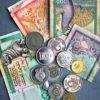ඉකොනමි ඔෆ් ශ්රී ලංකා ඉකොනමි ඔෆ් ශ්රී ලංකා
Economy
Sri Lanka is mainly an agricultural country. The chief crop is rice with which the country is almost self–sufficient. Tea, rubber and coconut are also important agricultural crops with tea being a major foreign exchange earner. In addition, other crops of importance are cocoa and spices such as cinnamon, car damom, nutmeg, pepper and clove. Fruit and vegetables, native to both tropical and temperate regions, grow well in Sri Lanka. Precious and semi–precious stones are also a major export of the country. Within the last few years remittances from Sri Lankans employed abroad have contributed a large share towards foreign exchange. The last three decades have seen tourism emerge as an important industry. There has also been a rapid growth in manufacturing industries which offer a wide range of export goods such as petroleum products, leather goods, ready made garments and electronic equipment.
Currency
Sri Lanka follows decimal currency systilable in the denominations of Rs. 1, 2, 5, 10, 20, 50, 100, 200, 500 and 1000 in Rupees (Rs.) and cents (Cts.) with 100 cents equal to a rupee. Currency. notes are available in 10, 20, 50, 100, 200, 500, and 1000. Coins are issued in values of Rs.1, 2, 5 and 10 and Cts.1, 2, 5, 10, 25 and 50. The US Dollar will continue to be the intervention currency.
South Africa Rand - 15.9913
Swiss Francs - 78.444
US Dollar - 101.619
Australian Dollar - 76.683
British Sterling Pounds - 179.344
Euro - 120.351
Japanese Yen - 0.843990



